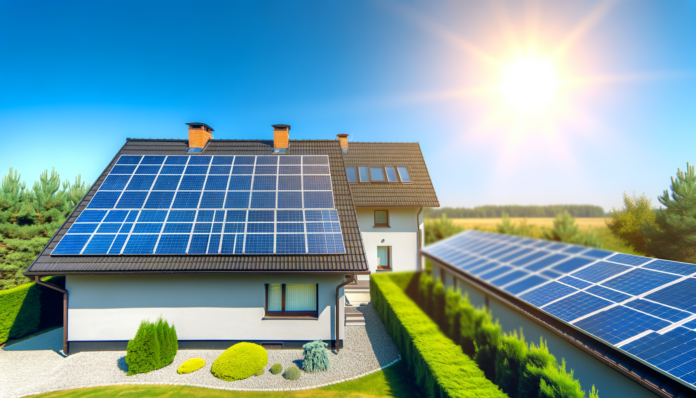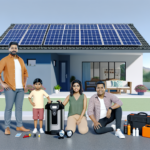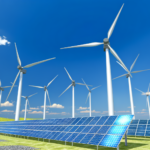Introduction to Solar Power Investment
The Importance of Sustainable Energy
In today’s world, the importance of sustainable energy cannot be overstated. As global populations grow and industrial activities expand, the demand for energy continues to rise. Traditional energy sources, such as fossil fuels, are not only finite but also contribute significantly to environmental degradation and climate change. Sustainable energy solutions, including solar power, offer a viable alternative that can help mitigate these issues. By harnessing renewable resources, we can reduce greenhouse gas emissions, decrease our reliance on non-renewable energy sources, and promote a healthier planet for future generations.
Why Invest in Solar Power?
Investing in solar power is a strategic decision that offers numerous benefits. Firstly, solar energy is abundant and inexhaustible. The sun provides more energy in one hour than the entire world consumes in a year. By tapping into this vast resource, individuals and businesses can achieve energy independence and reduce their utility bills. Additionally, solar power systems have become increasingly affordable due to advancements in technology and economies of scale. The cost of solar panels has dropped significantly over the past decade, making it a cost-effective option for many.
Moreover, solar power investments often yield attractive returns. The return on investment (ROI) for solar installations can be compelling, with payback periods typically shorter than the warrantied lifespans of the panels. Solar energy systems can also increase property values, as homes and buildings equipped with solar panels are often more attractive to buyers. Furthermore, various government incentives and tax credits are available to offset the initial costs, making solar power even more financially appealing.
Overview of Solar Power Systems
Solar power systems, also known as photovoltaic (PV) systems, convert sunlight directly into electricity. These systems consist of several key components:
- Solar Panels: These are the most visible part of the system and are responsible for capturing sunlight and converting it into direct current (DC) electricity.
- Inverters: Inverters convert the DC electricity generated by the solar panels into alternating current (AC) electricity, which is used by most household appliances and the electrical grid.
- Mounting Systems: These structures support the solar panels and ensure they are positioned at the optimal angle to capture maximum sunlight.
- Energy Storage Solutions: Batteries can be integrated into the system to store excess energy generated during the day for use at night or during cloudy periods.
- Monitoring Systems: These systems track the performance of the solar power system, providing real-time data on energy production and system health.
Solar power systems can be installed on rooftops, ground-mounted, or integrated into building materials. They are scalable and can be customized to meet the specific energy needs of residential, commercial, and industrial users. With proper installation and maintenance, solar power systems can provide reliable and sustainable energy for decades.
In conclusion, investing in solar power is a forward-thinking decision that aligns with global sustainability goals. By understanding the importance of sustainable energy, recognizing the benefits of solar power, and familiarizing oneself with the components of solar power systems, individuals and businesses can make informed choices that contribute to a greener and more sustainable future.
Choosing the Right Solar Power System
Assessing Your Energy Needs
Before investing in a solar power system, it’s crucial to understand your energy requirements. Start by examining your electricity bills to determine your average monthly consumption. This will give you a baseline for how much energy your solar panels need to generate. Additionally, consider any future changes in your energy usage, such as the addition of electric vehicles or new appliances, which may increase your energy needs.
To get a more accurate assessment, you can use online calculators or consult with a professional who can perform an energy audit of your home. This audit will help you identify areas where you can improve energy efficiency, which can, in turn, reduce the number of solar panels you need.
Types of Solar Power Systems
There are several types of solar power systems to choose from, each with its own set of advantages and disadvantages:
- Grid-Tied Systems: These systems are connected to the local utility grid, allowing you to draw power from the grid when your solar panels aren’t producing enough electricity. Excess energy generated by your panels can be fed back into the grid, often earning you credits through net metering.
- Off-Grid Systems: Ideal for remote locations, these systems are entirely independent of the utility grid. They require battery storage to store excess energy for use during nighttime or cloudy days. While they offer complete energy independence, they are generally more expensive due to the cost of batteries.
- Hybrid Systems: Combining the best of both worlds, hybrid systems are connected to the grid but also include battery storage. This setup allows you to store excess energy and use it during peak demand times or power outages, providing greater flexibility and reliability.
Factors to Consider When Choosing a System
Selecting the right solar power system involves considering several key factors:
- Budget: Determine how much you are willing to invest upfront. While solar panels have become more affordable, the initial cost can still be significant. However, various financing options, including loans, leases, and power purchase agreements, can make solar more accessible.
- Roof Condition and Space: Ensure your roof is in good condition and has enough space to accommodate the number of panels you need. If your roof is old or damaged, it may be wise to replace it before installing solar panels to avoid additional costs later.
- Local Climate: The amount of sunlight your location receives will impact the efficiency of your solar panels. Areas with more sunny days will generate more electricity, making solar a more viable option.
- Incentives and Rebates: Take advantage of federal, state, and local incentives that can significantly reduce the cost of your solar power system. The federal solar tax credit, for example, offers a 30% credit on the total cost of installation.
- Energy Storage Needs: Decide if you need a battery storage system. While batteries add to the initial cost, they provide energy independence and can be particularly beneficial in areas with frequent power outages or unfavorable net metering policies.
- Installer Reputation: Choose a reputable installer with good reviews and a solid track record. A professional installer will ensure your system is set up correctly and can provide ongoing maintenance and support.
By carefully assessing your energy needs, understanding the different types of solar power systems, and considering these critical factors, you can make an informed decision that maximizes the benefits of your solar power investment.
Installation and Setup
Preparing Your Site for Installation
Before installing a solar power system, it’s crucial to prepare your site adequately. This preparation ensures that your solar panels will operate efficiently and safely. Here are some key steps to follow:
- Site Assessment: Conduct a thorough assessment of your property to determine the best location for the solar panels. This involves evaluating the roof’s structural integrity, orientation, and shading. Ideally, the panels should face south in the Northern Hemisphere to maximize sunlight exposure.
- Permits and Regulations: Check local building codes and obtain any necessary permits. Compliance with regulations is essential to avoid legal issues and ensure the safety of your installation.
- Roof Condition: Ensure your roof is in good condition and can support the weight of the solar panels. If your roof needs repairs or replacement, it’s best to address these issues before installation.
- Clear Obstructions: Remove any obstructions such as trees, antennas, or chimneys that could cast shadows on the panels. Even partial shading can significantly reduce the efficiency of your solar power system.
DIY vs. Professional Installation
When it comes to installing a solar power system, you have two main options: doing it yourself (DIY) or hiring a professional installer. Each approach has its pros and cons.
DIY Installation
- Cost Savings: One of the primary advantages of DIY installation is the potential cost savings. By doing the work yourself, you can avoid labor costs associated with professional installation.
- Learning Experience: Installing your own solar power system can be a rewarding learning experience. You’ll gain a deeper understanding of how the system works and how to maintain it.
- Challenges: However, DIY installation can be challenging and time-consuming. It requires a good understanding of electrical systems and building codes. Mistakes can lead to inefficiencies or even safety hazards.
Professional Installation
- Expertise: Professional installers have the expertise and experience to ensure your system is installed correctly and efficiently. They can handle complex tasks such as wiring and securing permits.
- Warranty and Support: Many professional installers offer warranties and ongoing support, providing peace of mind that your system will be maintained and any issues will be addressed promptly.
- Higher Costs: The main drawback of professional installation is the higher upfront cost. However, this investment can be worthwhile for the quality and reliability of the installation.
Initial Setup and Configuration
Once your site is prepared and you’ve decided on the installation method, the next step is the initial setup and configuration of your solar power system.
- Mounting the Panels: The first step is to mount the solar panels on your roof or another suitable location. Ensure the panels are securely fastened and positioned at the optimal angle to capture maximum sunlight.
- Electrical Connections: Connect the solar panels to the inverter, which converts the direct current (DC) generated by the panels into alternating current (AC) for use in your home. Proper wiring is crucial for the system’s efficiency and safety.
- System Testing: After the panels and inverter are connected, test the system to ensure everything is working correctly. Check for any issues such as loose connections or faulty components.
- Monitoring Setup: Set up a monitoring system to track the performance of your solar power system. Many modern systems come with monitoring tools that allow you to view real-time data on energy production and usage.
- Grid Connection: If your system is designed to feed excess energy back into the grid, coordinate with your utility company to complete the grid connection. This may involve installing a bi-directional meter to measure the energy you send to and receive from the grid.
By carefully preparing your site, choosing the right installation method, and following proper setup procedures, you can ensure that your solar power system operates efficiently and provides sustainable energy for years to come.
Maintenance and Care
Regular Cleaning and Inspection
Maintaining your solar panels is crucial to ensure they operate at peak efficiency. **Regular cleaning** is one of the simplest yet most effective ways to care for your solar power system. Solar panels are exposed to the elements, which means they can accumulate dirt, dust, leaves, and other debris over time. This buildup can obstruct sunlight and reduce the panels’ efficiency.
It is generally recommended to clean your solar panels between two and four times per year. If your panels are installed at an angle, rain can help wash away some of the debris. However, during dry seasons or extended periods without rain, manual cleaning becomes necessary. Use a soft-bristled brush and a non-abrasive cleaner to gently clean the panels. Avoid using harsh chemicals or abrasive materials that could damage the surface. For safety, clean the panels early in the morning before they get too hot from the sun, as cold water on hot panels can cause cracks.
In addition to cleaning, **regular inspections** are essential. Check for any signs of physical damage, such as cracks or loose connections, especially after severe weather conditions like hailstorms or heavy winds. Inspect underneath the panels for debris or signs of animals nesting, which can also affect performance. If you notice any issues, it’s important to address them promptly to prevent further damage.
Monitoring System Performance
Monitoring the performance of your solar power system is another key aspect of maintenance. Most modern solar power systems come with monitoring tools that allow you to track how much energy your panels are generating. These tools can provide real-time data and historical performance metrics, helping you identify any drops in energy production.
By integrating a solar panel monitoring system into your setup, you can easily track the efficiency of your panels. If you notice a significant decrease in energy output, it could be a sign that your panels are obstructed by debris or experiencing other issues. Monitoring systems can also alert you to any malfunctions or failures, enabling you to take corrective action quickly.
Regularly reviewing your system’s performance data can help you understand how various external factors, such as weather conditions and seasonal changes, impact your panels. This information is invaluable for optimizing the efficiency and longevity of your solar power system.
Troubleshooting Common Issues
Despite their durability, solar panels can encounter issues that require troubleshooting. Here are some common problems and how to address them:
1. **Decreased Energy Output**: If your panels are producing less energy than usual, check for dirt, debris, or shading from nearby trees. Clean the panels and trim any overhanging branches. If the issue persists, it may be a sign of a more serious problem, such as a malfunctioning inverter or damaged panels.
2. **Physical Damage**: Inspect your panels for any visible damage, such as cracks or broken glass. Physical damage can occur due to severe weather or falling debris. If you find any damage, contact a professional to assess and repair the panels.
3. **Inverter Issues**: The inverter is a critical component that converts the DC electricity generated by the panels into AC electricity for your home. Regularly check the inverter’s display for any error messages or unusual readings. If you encounter any issues, consult a professional for assistance.
4. **Animal Interference**: Animals, such as birds or squirrels, can sometimes nest under solar panels, causing damage to wiring and other components. If you notice signs of animal activity, consider installing critter guards to protect your system.
By staying vigilant and addressing issues promptly, you can ensure your solar power system remains efficient and reliable. Regular maintenance and monitoring not only protect your investment but also contribute to a sustainable and eco-friendly energy solution.
Maximizing Efficiency
Optimal Placement and Angle
The efficiency of your solar power system is significantly influenced by the placement and angle of your solar panels. **Optimal placement** ensures that your panels receive the maximum amount of sunlight throughout the day. Ideally, solar panels should be installed on a south-facing roof in the Northern Hemisphere and a north-facing roof in the Southern Hemisphere. This orientation captures the most sunlight.
The **angle** of the panels is equally important. The optimal tilt angle generally corresponds to the latitude of your location. For instance, if you live at a latitude of 30 degrees, your panels should be tilted at approximately 30 degrees. Adjusting the angle seasonally can also enhance efficiency. In winter, a steeper angle captures the lower sun, while a flatter angle in summer maximizes exposure to the higher sun.
Energy Storage Solutions
To maximize the efficiency of your solar power system, consider integrating **energy storage solutions**. Solar batteries store excess energy generated during the day for use during nighttime or cloudy days. This not only ensures a continuous power supply but also reduces reliance on the grid, enhancing your energy independence.
**Lithium-ion batteries** are a popular choice due to their high energy density and long lifespan. They are efficient and can be easily integrated into existing solar power systems. Another option is **flow batteries**, which offer longer cycle life and are more suitable for large-scale energy storage.
Investing in a robust energy storage system can also provide backup power during outages, ensuring that your home remains powered even when the grid is down. This is particularly beneficial in areas prone to power interruptions.
Seasonal Adjustments
Seasonal changes can impact the performance of your solar power system. **Seasonal adjustments** help maintain optimal efficiency throughout the year. During winter, the sun is lower in the sky, and days are shorter. Adjusting the tilt angle of your panels to a steeper position can help capture more sunlight. Conversely, in summer, a flatter angle is more effective as the sun is higher and days are longer.
Regularly cleaning your panels is also crucial, especially after winter when snow and debris can accumulate. Ensuring that your panels are free from obstructions like snow, leaves, and dirt maximizes their exposure to sunlight.
Additionally, monitoring your system’s performance through the seasons can help identify any issues early. Many solar power systems come with monitoring tools that allow you to track energy production. If you notice a significant drop in performance, it may be time to inspect and adjust your system.
By optimizing placement and angle, investing in energy storage solutions, and making seasonal adjustments, you can significantly enhance the efficiency of your solar power system. These steps ensure that you get the most out of your investment, providing sustainable and reliable energy for years to come.
Upgrading and Expanding Your System
When to Consider an Upgrade
As solar technology continues to advance, there are several compelling reasons to consider upgrading your existing solar power system. Here are some key indicators that it might be time for an upgrade:
- Age of the System: If your solar system is more than 10 years old, it may be less efficient compared to newer models. Modern panels and inverters offer higher efficiency and better performance.
- Decreased Performance: If you notice a significant drop in energy production, it could be due to aging components or outdated technology. Upgrading can restore and even enhance your system’s output.
- Increased Energy Needs: If your household energy consumption has increased, an upgrade can help meet the new demand without relying on grid electricity.
- Technological Advancements: Newer systems come with advanced features such as better monitoring capabilities, smart home integration, and improved safety features.
- Incentives and Rebates: Government incentives and rebates for upgrading to more efficient systems can make the financial aspect more attractive.
Adding More Panels
Expanding your solar array by adding more panels is a straightforward way to increase your energy production. Here are some considerations for adding more panels:
- Available Space: Ensure you have enough roof space or ground area to accommodate additional panels. Consider the orientation and tilt to maximize sunlight exposure.
- System Compatibility: Check if your current inverter can handle the additional load. You might need to upgrade your inverter or add microinverters to manage the increased capacity.
- Permits and Regulations: Verify local regulations and obtain necessary permits for expanding your solar system. Some areas have specific guidelines for system expansions.
- Professional Assessment: Consult with a solar professional to assess the feasibility and design of the expanded system. They can provide insights into optimal placement and potential shading issues.
Integrating with Other Renewable Energy Sources
Diversifying your renewable energy portfolio by integrating other sources can enhance your energy independence and sustainability. Here are some options to consider:
- Wind Turbines: Combining solar panels with wind turbines can provide a more consistent energy supply, especially in areas with variable weather conditions. Wind energy can complement solar power during cloudy or nighttime periods.
- Hydropower: If you have access to a flowing water source, small-scale hydropower systems can be an excellent addition. They provide a steady energy output and can operate continuously.
- Geothermal Systems: Geothermal energy can be used for heating and cooling, reducing the overall energy demand on your solar system. This integration can lead to significant energy savings.
- Energy Storage Solutions: Adding battery storage to your system allows you to store excess energy generated during peak production times. This stored energy can be used during low production periods or power outages, enhancing your energy resilience.
By considering these upgrades and expansions, you can ensure that your solar power system continues to meet your energy needs efficiently and sustainably. Whether it’s upgrading to newer technology, adding more panels, or integrating with other renewable sources, these steps will help you maximize the benefits of your solar investment.
Conclusion and Future Trends
The Future of Solar Technology
The future of solar technology is incredibly promising, driven by continuous advancements and innovations. **Bifacial solar panels**, which capture sunlight from both sides, are becoming more prevalent, increasing energy production efficiency. **Solar + storage systems** are also gaining traction, allowing for the storage of excess energy for use during nighttime or cloudy days, thus providing consistent energy access and reducing reliance on the grid. Additionally, **thin-film solar cells** are paving the way for flexible, lightweight solar panels that can be integrated into building materials and even electric vehicles.
Another exciting development is the rise of **floating solar farms**, which are installed on bodies of water and offer a space-efficient way to harness solar energy. These innovations, coupled with supportive policies and financial incentives, are set to make solar power more accessible and efficient, even in regions with less year-round sunlight.
Long-term Benefits of Solar Power
Investing in solar power offers numerous long-term benefits, both economically and environmentally. Financially, solar power can significantly reduce electricity bills and increase property values. For instance, homes with solar systems often see a value boost, making it a smart investment. Additionally, government incentives like tax credits and net metering policies further enhance the financial appeal of solar energy.
Environmentally, solar power plays a crucial role in reducing greenhouse gas emissions and combating climate change. By shifting from fossil fuels to renewable energy sources, we can significantly lower our carbon footprint and contribute to a healthier planet. Solar power also promotes energy independence, reducing reliance on non-renewable energy sources and enhancing energy security.
Moreover, the solar industry is a significant job creator. As more people transition to clean energy, the demand for skilled solar installers, engineers, and maintenance technicians rises, contributing to economic growth and job creation.
Encouraging Sustainable Practices
Encouraging sustainable practices is essential for maximizing the benefits of solar power and ensuring a greener future. **Education and awareness** are key components in this effort. By informing the public about the advantages of solar energy and how to optimize its use, we can foster a culture of sustainability.
**Government policies and incentives** also play a crucial role. Policies that support renewable energy adoption, such as subsidies, tax credits, and net metering, make solar power more financially viable for individuals and businesses. Additionally, initiatives like community-based solar projects can empower local communities to take control of their energy future, promoting social cohesion and economic development.
**Technological integration** is another important aspect. Combining solar power with smart technologies, such as energy storage systems and smart grids, can enhance the efficiency and reliability of renewable energy solutions. Innovations in energy storage, for example, ensure that solar power is available even when the sun isn’t shining, making it a more practical and dependable energy source.
In conclusion, the future of solar technology is bright, with continuous advancements making it more efficient and accessible. The long-term benefits of solar power, both economically and environmentally, are substantial. By encouraging sustainable practices through education, supportive policies, and technological integration, we can maximize these benefits and pave the way for a greener, more sustainable future.






